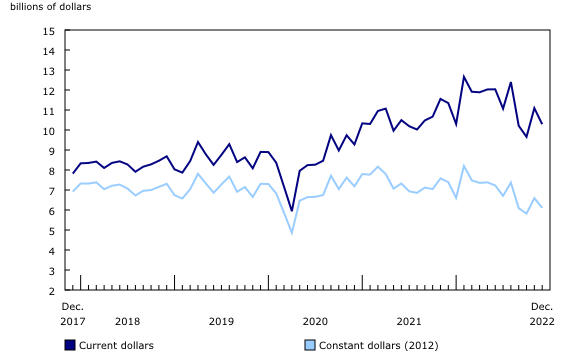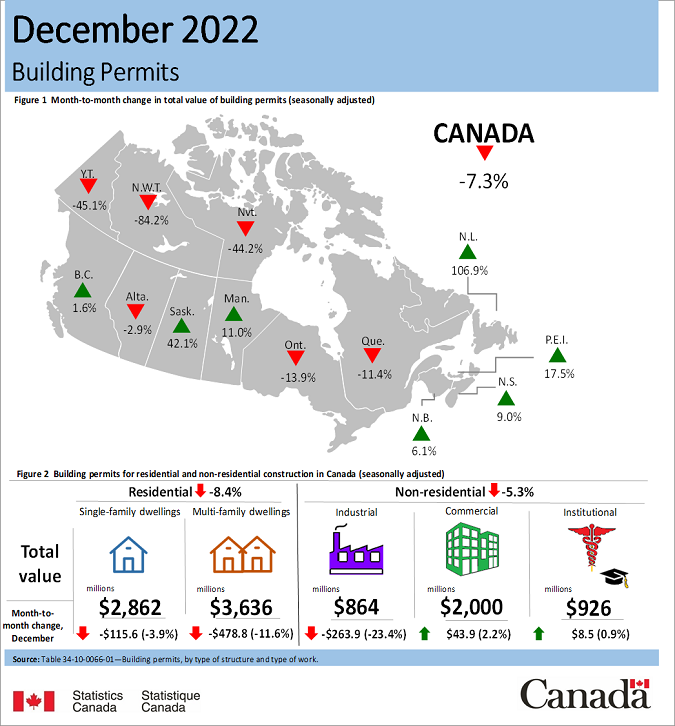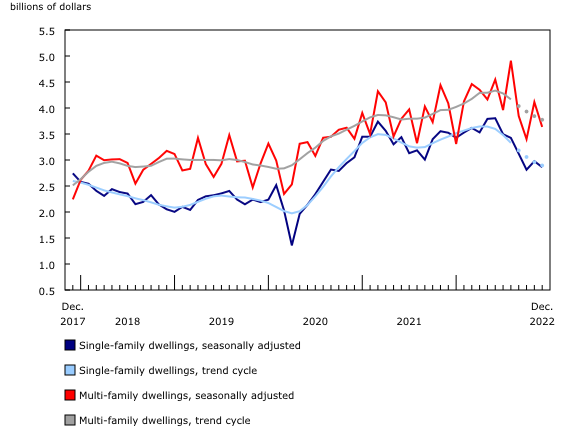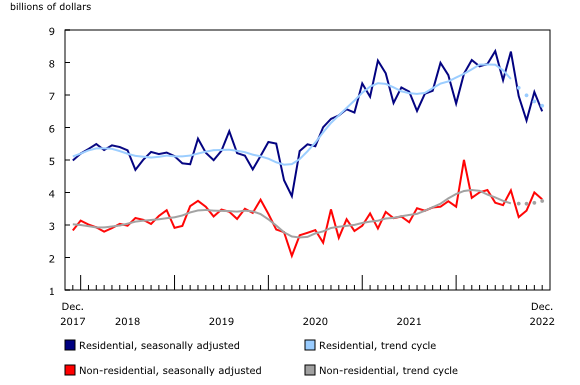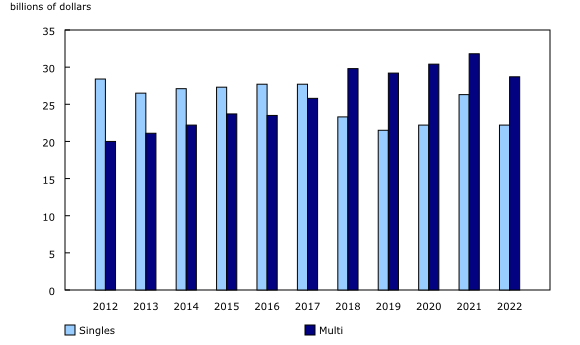By Statistics Canada
The monthly total seasonally adjusted value of building permits in Canada decreased 7.3% in December to $10.3 billion. Declines were posted in both the residential and the non-residential sectors.
On a constant dollar basis (2012=100), the total value of building permits fell 7.4% to $6.1 billion.
Chart 1 
Total value of building permits, seasonally adjusted
Infographic 1 
Building permits, December 2022
Residential sector down in December following a strong November
The total value of residential permits declined 8.4% to $6.5 billion in December.
Construction intentions in the single-family homes component decreased 3.9% while multi-family permit values fell 11.6%, with seven provinces posting declines. Quebec (-43.4%) contributed to much of the decline in the multi-family component following a strong November. Conversely, notable gains were posted in New Brunswick (+46.4%) and Saskatchewan (+36.9%) in December.
Chart 2 
Value of building permits for the single-family and multi-family components
Chart 3 
Value of building permits for the residential and non-residential sectors
Ontario drags down non-residential sector
The total value of non-residential permits declined 5.3% to $3.8 billion in December. Decreases posted in Ontario more than offset gains posted in seven provinces.
Construction intentions in the industrial sector decreased 23.4% in December, following a record high in November.
In December, the value of commercial permits edged up 2.2%, with seven provinces posting increases. Alberta led the way with a variety of large permits in Calgary.
The total value of institutional building permits posted a modest growth month over month (+0.9%). Large losses in Ontario (-30.1%) were offset by notable gains in Quebec (+45.1%), Manitoba (+228.6%) and Saskatchewan (+333.8%). The superlative results in the latter two provinces were driven by building permits for new hospital construction.
Fourth quarter construction intentions continue to slow
The total value of building permits in the fourth quarter of 2022 decreased 7.8% from the previous quarter to $31.0 billion.
The residential sector decreased for the second consecutive quarter in the fourth quarter after a year of multiple interest rate hikes. Rising interest rates impact construction intentions, as they increase the costs for new projects and can make it more difficult for developers and buyers to secure financing. Construction intentions fell 13.0% to $19.8 billion in the quarter, with declines posted in all provinces except Newfoundland and Labrador. Single-family permits decreased 13.8%, while multi-family permits dropped 12.3%.
The non-residential sector increased by 2.9% to $11.2 billion, led by the industrial component, which sharply increased by 29.5% to a record quarterly high ($2.8 billion). Commercial permit values remained relatively stable (+0.3%), while institutional permit values fell by 12.3% for a third consecutive quarterly decrease.
Annual review of 2022: trending decline for building permits of single-family homes
The total current dollar value of building permits continued to climb to new records, increasing 6.8% in 2022. However, the annual increase was largely the result of inflated valuations from persistent material and labour cost increases. On a constant dollar basis (2012=100), the total value of building permits declined 6.6% to $83.0 billion.
The remainder of the article will be presented in constant dollars to eliminate the impact of changes in purchasing power of the dollar over time.
After three consecutive yearly increases, construction intentions in the residential sector declined 12.3% to $50.9 billion. Decreases in the value of single-family permits (-15.5%) outpaced the decline in multi-family permits (-9.6%) in 2022.
The amount and mix of residential permits for single and multi-family homes can be attributed to a multitude of supply and demand factors, such as shifting household characteristics and preferences, changing construction regulations, and the price of single and multi-family homes. Chart 4 shows that over time, residential construction intentions have shifted away from single-family buildings, which composed of 58.8% of the value of residential building permits 10 years earlier compared with 43.6% in 2022. This translated to 84,000 units ($28.4 billion) being issued for single-family homes in 2012 compared with 72,000 new single-family units in 2022 ($22.2 billion), despite a population increase of over four million people over the same period.
Chart 4 
Value of residential building permits in constant dollars (2012)
The non-residential sector was up 4.1% to $32.0 billion in 2022. Despite a second consecutive yearly increase, the sector remains below pre-COVID-19 pandemic levels ($34.6 billion in 2019). Much of the increase was due to the industrial component, which sharply increased by 20.1%. This was led by 10 industrial permits valued over $100 million throughout the year, including a $425 million permit in November for a manufacturing facility in Toronto.
Despite the largest building permit of the year being worth almost $1.5 billion for a new hospital in Vancouver, the institutional component advanced 3.0%. The commercial component posted a marginal decline of 0.7% on an annual basis.
